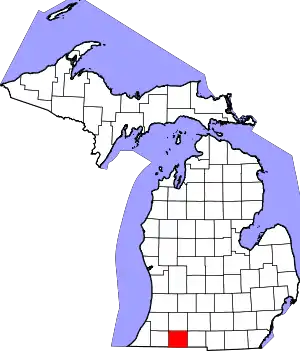Constantine, Michigan
Constantine is a village in St. Joseph County in the U.S. state of Michigan. The population was 2,076 at the 2010 census. The village is located within Constantine Township. U.S. Highway 131 (Main Street in the village) leads to Kalamazoo to the north and to the Indiana Toll Road six miles to the south. The St. Joseph River, navigable from source to outlet, passes through the village, emptying in Lake Michigan to the west.
Constantine, Michigan | |
|---|---|
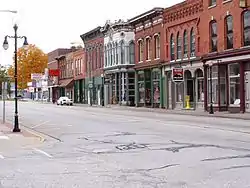 Main Street, Old U.S. 131 through town | |
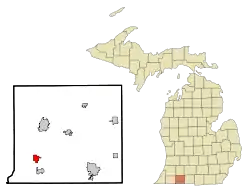 Location of Constantine, Michigan | |
| Coordinates: 41°50′23″N 85°39′53″W | |
| Country | United States |
| State | Michigan |
| County | St. Joseph |
| Area | |
| • Total | 1.78 sq mi (4.61 km2) |
| • Land | 1.62 sq mi (4.19 km2) |
| • Water | 0.16 sq mi (0.42 km2) |
| Elevation | 787 ft (240 m) |
| Population | |
| • Total | 2,076 |
| • Estimate (2019)[3] | 2,111 |
| • Density | 1,305.50/sq mi (504.16/km2) |
| Time zone | UTC-5 (Eastern (EST)) |
| • Summer (DST) | UTC-4 (EDT) |
| FIPS code | 26-17840[4] |
| GNIS feature ID | 1624472[5] |
| Website | Village website |
The telephone provider is Verizon and the electric provider is AEP Indiana Michigan Power. Located in an agricultural area, Constantine is known as the Seed Corn Capital of the World, as both Monsanto and Pioneer having their biggest facilities located here.
Constantine is the birthplace of Harry Hill Bandholtz, a US brigadier general in World War I and head of the US Military Mission to Hungary.
History
The Potawatomi and related Native Americans historically had villages along the St. Joseph River and other waterways. Several of their leaders signed the Treaty of Chicago, agreeing to cede much of their land in southwestern Michigan, Indiana and Ohio country.
The village was platted in 1831 at the Fawn River's confluence with the St. Joseph River, where three European-American families had settled. A gristmill, the first in the county to run by water, had been built here in 1830.[6]
It was first named Meeks Mill after Johnathon Meeks, who built the first grain mill. A Yankee from New York or New England, he moved to several other frontier areas, each time having a town named after him. When using names of classical figures later came into vogue, the village was renamed for the Roman emperor Constantine the Great.[7]
The Main Street of town is a historic center with richly detailed, two-story commercial buildings of the late 19th century. It is designated US 131 through the village and connected to newer roads outside.
Geography
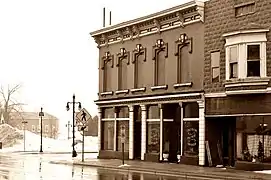
According to the United States Census Bureau, the village has a total area of 1.77 square miles (4.58 km2), of which 1.61 square miles (4.17 km2) is land and 0.16 square miles (0.41 km2) is water.[8]
Demographics
| Historical population | |||
|---|---|---|---|
| Census | Pop. | %± | |
| 1850 | 760 | — | |
| 1860 | 879 | 15.7% | |
| 1870 | 1,290 | 46.8% | |
| 1880 | 1,405 | 8.9% | |
| 1890 | 1,346 | −4.2% | |
| 1900 | 1,226 | −8.9% | |
| 1910 | 1,244 | 1.5% | |
| 1920 | 1,277 | 2.7% | |
| 1930 | 1,259 | −1.4% | |
| 1940 | 1,384 | 9.9% | |
| 1950 | 1,514 | 9.4% | |
| 1960 | 1,710 | 12.9% | |
| 1970 | 1,733 | 1.3% | |
| 1980 | 1,680 | −3.1% | |
| 1990 | 2,032 | 21.0% | |
| 2000 | 2,095 | 3.1% | |
| 2010 | 2,076 | −0.9% | |
| 2019 (est.) | 2,111 | [3] | 1.7% |
| U.S. Decennial Census[9] | |||
2010 census
As of the census[2] of 2010, there were 2,076 people, 728 households, and 522 families living in the village. The population density was 1,289.4 inhabitants per square mile (497.8/km2). There were 829 housing units at an average density of 514.9 per square mile (198.8/km2). The racial makeup of the village was 91.5% White, 1.8% African American, 0.9% Native American, 0.5% Asian, 2.4% from other races, and 3.0% from two or more races. Hispanic or Latino of any race were 3.3% of the population.
There were 728 households, of which 45.1% had children under the age of 18 living with them, 47.5% were married couples living together, 18.8% had a female householder with no husband present, 5.4% had a male householder with no wife present, and 28.3% were non-families. 22.7% of all households were made up of individuals, and 7.7% had someone living alone who was 65 years of age or older. The average household size was 2.85 and the average family size was 3.27.
The median age in the village was 31.2 years. 31.6% of residents were under the age of 18; 9.3% were between the ages of 18 and 24; 28.2% were from 25 to 44; 22% were from 45 to 64; and 8.9% were 65 years of age or older. The gender makeup of the village was 49.2% male and 50.8% female.
2000 census
As of the census[4] of 2000, there were 2,095 people, 763 households, and 557 families living in the village. The population density was 1,291.9 per square mile (499.3/km2). There were 836 housing units at an average density of 515.5 per square mile (199.2/km2). The racial makeup of the village was 95.42% White, 0.62% African American, 0.14% Native American, 0.86% Asian, 0.48% from other races, and 2.48% from two or more races. Hispanic or Latino of any race were 1.43% of the population.
There were 763 households, out of which 43.5% had children under the age of 18 living with them, 49.9% were married couples living together, 15.2% had a female householder with no husband present, and 26.9% were non-families. 22.5% of all households were made up of individuals, and 11.0% had someone living alone who was 65 years of age or older. The average household size was 2.75 and the average family size was 3.12.
In the village, the population was spread out, with 32.0% under the age of 18, 9.9% from 18 to 24, 29.7% from 25 to 44, 18.1% from 45 to 64, and 10.3% who were 65 years of age or older. The median age was 30 years. For every 100 females, there were 96.5 males. For every 100 females age 18 and over, there were 91.4 males.
The median income for a household in the village was $40,428, and the median income for a family was $44,236. Males had a median income of $35,469 versus $23,152 for females. The per capita income for the village was $15,542. About 14.1% of families and 15.5% of the population were below the poverty line, including 20.9% of those under age 18 and 8.2% of those age 65 or over.
Arts and culture
Tourism
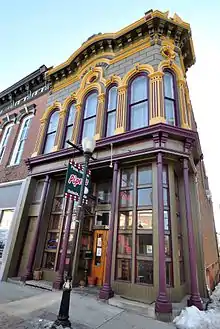
John S. Barry, the fourth and eighth Governor of Michigan resided in Constantine. Barry's home, the Governor John S. Barry House, is on the National Register of Historic Places since 1972.[10][11]
Notable people
- Harry Hill Bandholtz, US brigadier general in World War I and head of the US Military Mission to Hungary, was born here.[12]
- John S. Barry (1802–1870), fourth and eighth governor of Michigan[13]
- George J. Sweetland (1872–1954) physician, athletic administrator and college coach [14]
- Joseph R. Williams (1808-1861), first President of Michigan Agricultural College, later to become Michigan State University. He was also the 14th Lt. Governor of Michigan in 1861.
References
- "2019 U.S. Gazetteer Files". United States Census Bureau. Retrieved July 25, 2020.
- "U.S. Census website". United States Census Bureau. Retrieved 2012-11-25.
- "Population and Housing Unit Estimates". United States Census Bureau. May 24, 2020. Retrieved May 27, 2020.
- "U.S. Census website". United States Census Bureau. Retrieved 2008-01-31.
- "US Board on Geographic Names". United States Geological Survey. 2007-10-25. Retrieved 2008-01-31.
- Fuller, George Newman (1916). Economic and Social Beginnings of Michigan, p. 274. Wynkoop Hallenbeck Crawford Co.
- Gannett, Henry (1905). The Origin of Certain Place Names in the United States. Govt. Print. Off. pp. 90.
- "US Gazetteer files 2010". United States Census Bureau. Archived from the original on 2012-01-25. Retrieved 2012-11-25.
- "Census of Population and Housing". Census.gov. Retrieved June 4, 2015.
- "Gov. John S. Barry House, Constantine". Go HIstoric. Archived from the original on February 2, 2014. Retrieved January 19, 2014.
- "The History of St. Joseph County, Michigan". Southwest Michigan Business & Tourism Directory. Retrieved January 19, 2014.
- Garfield, Patrick V. (2009). A Forgotten Soldier: The Life and Times of Major General Harry Hill Bandholtz. Pennsylvania: Infinity Publishing. p. 2. ISBN 9780741451897.
- PORTRAIT AND BIOGRAPHICAL ALBUM OF Barry and Eaton Counties, Mich. 1891. p. 113.
- Sesquicentennial Committee (1978), Village of Constantine: Reflections of 150 Years, Constantine, Michigan, 1828-1978 Sesquicentennial, Sesquicentennial Committee
